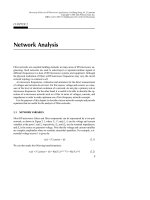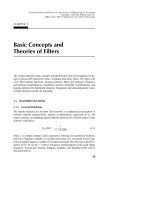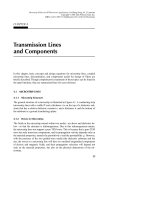Tài liệu Lò vi sóng RF và hệ thống không dây P5 pdf
Bạn đang xem bản rút gọn của tài liệu. Xem và tải ngay bản đầy đủ của tài liệu tại đây (288.03 KB, 23 trang )
CHAPTER FIVE
Receiver System Parameters
5.1 TYPICAL RECEIVERS
A receiver picks up the modulated carrier signal from its antenna. The carrier signal
is downconverted, and the modulating signal (information) is recovered. Figure 5.1
shows a diagram of typical radio receivers using a double-conversion scheme. The
receiver consists of a monopole antenna, an RF amplifier, a synthesizer for LO
signals, an audio amplifier, and various mixers, IF amplifiers, and filters. The input
signal to the receiver is in the frequency range of 20–470 MHz; the output signal is
an audio signal from 0 to 8 kHz. A detector and a variable attenuator are used for
automatic gain control (AGC). The received signal is first downconverted to the first
IF frequency of 515 MHz. After amplification, the first IF frequency is further
downconverted to 10.7 MHz, which is the second IF frequency. The frequency
synthesizer generates a tunable and stable LO signal in the frequency range of 535–
985 MHz to the first mixer. It also provides the LO signal of 525.7 MHz to the
second mixer.
Other receiver examples are shown in Fig. 5.2. Figure 5.2a shows a simplified
transceiver block diagram for wireless communications. A T=R switch is used to
separate the transmitting and receiving signals. A synthesizer is employed as the LO
to the upconverter and downconverter. Figure 5.2b is a mobile phone transceiver
(transmitter and receiver) [1]. The transceiver consists of a transmitter and a receiver
separated by a filter diplexer (duplexer). The receiver has a low noise RF amplifier, a
mixer, an IF amplifier after the mixer, bandpass filters before and after the mixer, and
a demodulator. A frequency synthesizer is used to generate the LO signal to the
mixer.
Most components shown in Figs. 5.1 and 5.2 have been described in Chapters 3
and 4. This chapter will discuss the system parameters of the receiver.
149
RF and Microwave Wireless Systems. Kai Chang
Copyright # 2000 John Wiley & Sons, Inc.
ISBNs: 0-471-35199-7 (Hardback); 0-471-22432-4 (Electronic)
5.2 SYSTEM CONSIDERATIONS
The receiver is used to process the incoming signal into useful information, adding
minimal distortion. The performance of the receiver depends on the system design,
circuit design, and working environment. The acceptable level of distortion or noise
varies with the application. Noise and interference, which are unwanted signals that
appear at the output of a radio system, set a lower limit on the usable signal level at
the output. For the output signal to be useful, the signal power must be larger than
the noise power by an amount specified by the required minimum signal-to-noise
ratio. The minimum signal-to-noise ratio depends on the application, for example,
30 dB for a telephone line, 40 dB for a TV system, and 60 dB for a good music
system.
To facilitate the discussion, a dual-conversion system as shown in Fig. 5.3 is used.
A preselector filter (Filter 1) limits the bandwidth of the input spectrum to minimize
the intermodulation and spurious responses and to suppress LO energy emission.
The RF amplifier will have a low noise figure, high gain, and a high intercept point,
set for receiver performance. Filter 2 is used to reject harmonics generated by the RF
amplifier and to reject the image signal generated by the first mixer. The first mixer
generates the first IF signal, which will be amplified by an IF amplifier. The IF
amplifier should have high gain and a high intercept point. The first LO source
should have low phase noise and sufficient power to pump the mixer. The receiver
system considerations are listed below.
1. Sensitivity. Receiver sensitivity quantifies the ability to respond to a weak
signal. The requirement is the specified signal-noise ratio (SNR) for an analog
receiver and bit error rate (BER) for a digital receiver.
FIGURE 5.1 Typical radio receiver.
150
RECEIVER SYSTEM PARAMETERS
FIGURE 5.2 (a) Simplified transceiver block diagram for wireless communications.
(b) Typical mobile phone transceiver system. (From reference [1], with permission from
IEEE.)
FIGURE 5.3 Typical dual-conversion receiver.
5.2 SYSTEM CONSIDERATIONS
151
2. Selectivity. Receiver selectivity is the ability to reject unwanted signals on
adjacent channel frequencies. This specification, ranging from 70 to 90 dB, is
difficult to achieve. Most systems do not allow for simultaneously active
adjacent channels in the same cable system or the same geographical area.
3. Spurious Response Rejection. The ability to reject undesirable channel
responses is important in reducing interference. This can be accomplished
by properly choosing the IF and using various filters. Rejection of 70 to
100 dB is possible.
4. Intermodulation Rejection. The receiver has the tendency to generate its own
on-channel interference from one or more RF signals. These interference
signals are called intermodulation (IM) products. Greater than 70 dB rejection
is normally desirable.
5. Frequency Stability. The stability of the LO source is important for low FM
and phase noise. Stabilized sources using dielectric resonators, phase-locked
techniques, or synthesizers are commonly used.
6. Radiation Emission. The LO signal could leak through the mixer to the
antenna and radiate into free space. This radiation causes interference and
needs to be less than a certain level specified by the FCC.
5.3 NATURAL SOURCES OF RECEIVER NOISE
The receiver encounters two types of noise: the noise picked up by the antenna and
the noise generated by the receiver. The noise picked up by the antenna includes sky
noise, earth noise, atmospheric (or static) noise, galactic noise, and man-made noise.
The sky noise has a magnitude that varies with frequency and the direction to which
the antenna is pointed. Sky noise is normally expressed in terms of the noise
temperature ðT
A
Þ of the antenna. For an antenna pointing to the earth or to the
horizon T
A
’ 290 K. For an antenna pointing to the sky, its noise temperature could
be a few kelvin. The noise power is given by
N ¼ kT
A
B ð5:1Þ
where B is the bandwidth and k is Boltzmann’s constant,
k ¼ 1:38 Â 10
À23
J=K
Static or atmospheric noise is due to a flash of lightning somewhere in the world.
The lightning generates an impulse noise that has the greatest magnitude at 10 kHz
and is negligible at frequencies greater than 20 MHz.
Galactic noise is produced by radiation from distant stars. It has a maximum
value at about 20 MHz and is negligible above 500 MHz.
152
RECEIVER SYSTEM PARAMETERS
Man-made noise includes many different sources. For example, when electric
current is switched on or off, voltage spikes will be generated. These transient spikes
occur in electronic or mechanical switches, vehicle ignition systems, light switches,
motors, and so on. Electromagnetic radiation from communication systems, broad-
cast systems, radar, and power lines is everywhere, and the undesired signals can be
picked up by a receiver. The interference is always present and could be severe in
urban areas.
In addition to the noise picked up by the antenna, the receiver itself adds further
noise to the signal from its amplifier, filter, mixer, and detector stages. The quality of
the output signal from the receiver for its intended purpose is expressed in terms of
its signal-to-noise ratio (SNR):
SNR ¼
wanted signal power
unwanted noise power
ð5:2Þ
A tangential detectable signal is defined as SNR ¼ 3 dB (or a factor of 2). For a
mobile radio-telephone system, SNR > 15 dB is required from the receiver output.
In a radar system, the higher SNR corresponds to a higher probability of detection
and a lower false-alarm rate. An SNR of 16 dB gives a probability detection of
99.99% and a probability of false-alarm rate of 10
À6
[2].
The noise that occurs in a receiver acts to mask weak signals and to limit the
ultimate sensitivity of the receiver. In order for a signal to be detected, it should have
a strength much greater than the noise floor of the system. Noise sources in
thermionic and solid-state devices may be divided into three major types.
1. Thermal, Johnson, or Nyquist Noise. This noise is caused by the random
fluctuations produced by the thermal agitation of the bound charges. The rms
value of the thermal resistance noise voltage of V
n
over a frequency range B is
given by
V
2
n
¼ 4kTBR ð5:3Þ
where k ¼ Boltzman constant ¼ 1:38 Â 10
À23
J=K
T ¼ resistor absolute temperature; K
B ¼ bandwidth; Hz
R ¼ resistance; O
From Eq. (5.3), the noise power can be found to exist in a given bandwidth
regardless of the center frequency. The distribution of the same noise-per-unit
bandwidth everywhere is called white noise.
2. Shot Noise. The fluctuations in the number of electrons emitted from the
source constitute the shot noise. Shot noise occurs in tubes or solid-state
devices.
5.3 NATURAL SOURCES OF RECEIVER NOISE
153
3. Flicker, or 1=f, Noise. A large number of physical phenomena, such as
mobility fluctuations, electromagnetic radiation, and quantum noise [3],
exhibit a noise power that varies inversely with frequency. The 1=f noise is
important from 1 Hz to 1 MHz. Beyond 1 MHz, the thermal noise is more
noticeable.
5.4 RECEIVER NOISE FIGURE AND EQUIVALENT NOISE TEMPERATURE
Noise figure is a figure of merit quantitatively specifying how noisy a component or
system is. The noise figure of a system depends on a number of factors such as
losses in the circuit, the solid-state devices, bias applied, and amplification. The
noise factor of a two-port network is defined as
F ¼
SNR at input
SNR at output
¼
S
i
=N
i
S
o
=N
o
ð5:4Þ
The noise figure is simply the noise factor converted in decibel notation.
Figure 5.4 shows the two-port network with a gain (or loss) G.Wehave
S
o
¼ GS
i
ð5:5Þ
Note that N
o
6¼ GN
i
; instead, the output noise N
o
¼ GN
i
þ noise generated by the
network. The noise added by the network is
N
n
¼ N
o
À GN
i
ðWÞð5:6Þ
Substituting (5.5) into (5.4), we have
F ¼
S
i
=N
i
GS
i
=N
o
¼
N
o
GN
i
ð5:7Þ
Therefore,
N
o
¼ FGN
i
ðWÞð5:8Þ
FIGURE 5.4 Two-port network with gain G and added noise power N
n
.
154
RECEIVER SYSTEM PARAMETERS
Equation (5.8) implies that the input noise N
i
(in decibels) is raised by the noise
figure F (in decibels) and the gain (in decibels).
Since the noise figure of a component should be independent of the input noise, F
is based on a standard input noise source N
i
at room temperature in a bandwidth B,
where
N
i
¼ kT
0
B ðWÞð5:9Þ
where k is the Boltzmann constant, T
0
¼ 290 K (room temperature), and B is the
bandwidth. Then, Eq. (5.7) becomes
F ¼
N
o
GkT
0
B
ð5:10Þ
For a cascaded circuit with n elements as shown in Fig. 5.5, the overall noise factor
can be found from the noise factors and gains of the individual elements [4]:
F ¼ F
1
þ
F
2
À 1
G
1
þ
F
3
À 1
G
1
G
2
þÁÁÁþ
F
n
À 1
G
1
G
2
ÁÁÁG
nÀ1
ð5:11Þ
Equation (5.11) allows for the calculation of the noise figure of a general cascaded
system. From Eq. (5.11), it is clear that the gain and noise figure in the first stage are
critical in achieving a low overall noise figure. It is very desirable to have a low noise
figure and high gain in the first stage. To use Eq. (5.11), all F’s and G’s are in ratio.
For a passive component with loss L in ratio, we will have G ¼ 1=L and F ¼ L [4].
Example 5.1 For the two-element cascaded circuit shown in Fig. 5.6, prove that
the overall noise factor
F ¼ F
1
þ
F
2
À 1
G
1
Solution From Eq. (5.10)
N
o
¼ F
12
G
12
kT
0
BN
o1
¼ F
1
G
1
kT
0
B
From Eqs. (5.6) and (5.8)
N
n2
¼ðF
2
À 1ÞG
2
kT
0
B
FIGURE 5.5 Cascaded circuit with n networks.
5.4 RECEIVER NOISE FIGURE AND EQUIVALENT NOISE TEMPERATURE
155
From Eq. (5.6)
N
o
¼ N
o1
G
2
þ N
n2
Substituting the first three equations into the last equation leads to
N
o
¼ F
1
G
1
G
2
kT
0
B þðF
2
À 1ÞG
2
kT
0
B
¼ F
12
G
12
kT
0
B
Overall,
F ¼ F
12
¼
F
1
G
1
G
2
kT
0
B
G
1
G
2
kT
0
B
þ
ðF
2
À 1ÞG
2
kT
0
B
G
1
G
2
kT
0
B
¼ F
1
þ
F
2
À 1
G
1
The proof can be generalized to n elements. j
Example 5.2 Calculate the overall gain and noise figure for the system shown in
Fig. 5.7.
FIGURE 5.7 Cascaded amplifiers.
FIGURE 5.6 Two-element cascaded circuit.
156
RECEIVER SYSTEM PARAMETERS
Solution
F
1
¼ 3dB¼ 2 F
2
¼ 5dB¼ 3:162
G
1
¼ 20 dB ¼ 100 G
2
¼ 20 dB ¼ 100
G ¼ G
1
G
2
¼ 10;000 ¼ 40 dB
F ¼ F
1
þ
F
2
À 1
G
1
¼ 2 þ
3:162 À 1
100
¼ 2 þ 0:0216 ¼ 2:0216 ¼ 3:06 dB: j
Note that F % F
1
due to the high gain in the first stage. The first-stage amplifier
noise figure dominates the overall noise figure. One would like to select the first-
stage RF amplifier with a low noise figure and a high gain to ensure the low noise
figure for the overall system.
The equivalent noise temperature is defined as
T
e
¼ðF À 1ÞT
0
ð5:12Þ
where T
0
¼ 290 K (room temperature) and F in ratio. Therefore,
F ¼ 1 þ
T
e
T
0
ð5:13Þ
Note that T
e
is not the physical temperature. From Eq. (5.12), the corresponding T
e
for each F is given as follows:
F ðdBÞ 32:28 1:29 0:82 0:29
T
e
ðKÞ 290 200 100 60 20
For a cascaded circuit shown as Fig. 5.8, Eq. (5.11) can be rewritten as
T
e
¼ T
e1
þ
T
e2
G
1
þ
T
e3
G
1
G
2
þÁÁÁþ
T
en
G
1
G
2
ÁÁÁG
nÀ1
ð5:14Þ
where T
e
is the overall equivalent noise temperature in kelvin.
FIGURE 5.8 Noise temperature for a cascaded circuit.
5.4 RECEIVER NOISE FIGURE AND EQUIVALENT NOISE TEMPERATURE
157









